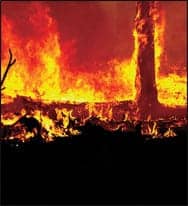Warning: Undefined array key "file" in /www/respiratorytherapy_860/public/wp-includes/media.php on line 1723
One Oceanside, Calif, hospital learned in real time just how prepared they were for a disaster when five wildfires broke out within San Diego County in October 2007
 |
Shortly after 2 am on October 22, 2007, Kevin McQueen, RCP, RRT, CM, awoke to the light of a blazing hillside less than a mile outside his bedroom window. That October, five major wildfires broke out within San Diego County and threatened the homes of hundreds of thousands of residents, including McQueen and his family. As fire trucks raced around his neighborhood, McQueen prepared his family for evacuation and headed to his workplace: Tri-City Medical Center (TCMC) in Oceanside, where he serves as operations manager of the pulmonary services department.
Over the next week, the fires would cause millions of dollars in damages and force evacuations of more than 500,000 people. The five major wildfires would eventually cause significant disruptions to the county’s health care system, but as McQueen arrived at TCMC early that morning, things were still operating as usual. The hospital had not yet begun to experience an influx of patients related to the fires, but the disaster team at TCMC investigated the status of the ominous situation and quickly sprang into action. The team decided an important first step was to set up surge capacity tents.
“We had time to get things set up before the influx of patients started,” says McQueen. “This coupled with the fact that the team had practiced setting up the tents many times helped us know immediately what to do.”
 |
| Kevin McQueen, RCP, RRT, CM |
Although the team at TCMC practices setting up the tents and preparing for disasters at least two or three times a year, McQueen and his fellow staff members were still called upon to make last-minute changes in plans and supplement areas of the plans that had been overlooked. The quick thinking of the disaster team at TCMC kept things running smoothly during the wildfires and could serve as helpful tweaks to your facility’s disaster plan.
Surge Capacity Tents
TCMC has two large surge capacity tents, which hold approximately 20 patients each. Additionally, the hospital has a smaller surge tent and one double decontamination tent used mostly as a showering system and not for housing patients.
During the wildfires, McQueen and the disaster team used two surge capacity tents for urgent care. Patients with minor injuries such as lacerations, twisted ankles, and other evacuation-related injuries that did not require an IV were sent to the tents to take the burden off the main emergency department.
McQueen highlights four main considerations to take into account when dealing with surge tents:
- access to power;
- access to the hospital’s wireless computer systems;
- a means of tracking patients specific to the disaster for data;
- customer service.
“Our hospital’s regular disaster plan has the surge tents located away from the emergency department in an effort to keep patients with potentially infectious diseases or chemical exposure away from the facility,” says McQueen. “After reviewing the fire situation, a decision was made to bring the tents close to the building where we could have more protection from a hospital overhang and increased efficiencies in triaging and treating patients.”
With the change in location, making sure there was access to electrical power in the tents was essential. The new location had great access to power and some roof coverage over the top with lights on the underside. This supplied a soft light to the tents, which the hospital supplemented by beaming lights in from the outside. The tents were also outfitted with HEPA filtration systems.
“We thought that a lot of people would be offended to be sent to the tent. We made it a point to provide the highest level of customer service possible—it was TLC all the way,” says McQueen. “We immediately apologized to the people that we were having to do this, and we explained that it was due to the fires, etc. It turned out that [the patients sent to the tent] really liked it! Not a single person complained, and, in fact, they were grateful they didn’t have to sit in the busy waiting room.”
 |
| TCMC’s disaster plan even includes agreements for helicopter drops of supplies in the event that deliveries are unavailable by other avenues |
Respiratory Therapy in the Surge Tents
Patients presenting with smoke inhalation injuries and other minor respiratory problems were also sent to the surge tents. McQueen served as tent commander, while his respiratory team kept things running smoothly inside the hospital so that he was not needed there.
As the sole respiratory therapist in the tents, McQueen administered nebulizer treatments, coached on the use of inhalers, and educated patients on how to stay out of excessive smoke and how to watch for signs and symptoms of an exacerbation of respiratory symptoms.
Supplies
A well-thought-out supply plan came in handy for TCMC during the 2007 fires. The medical center keeps certain supplies on site for surge capacity, but does not stockpile huge amounts, because it utilizes a just-in-time (JIT) supply strategy. The JIT strategy is intended to reduce in-process inventory and the associated carrying costs. Because of this, TCMC has a thorough plan worked out with Cardinal Health (which collaborates with TCMC) to get the needed supplies to the hospital one way or another. “We went as far as to set up agreements for helicopter drops in case we needed it,” says McQueen, “… which we didn’t.”
The Incident Command Center
The incident command center at TCMC was instantly set up when the hospital sprung into disaster mode. This small room proved to be an invaluable resource for information flow from outside the hospital while also keeping the inside of the hospital organized and efficient during this hectic time.
“One of the biggest things we learned after doing several drills was that a small room was the best option as a command center and only certain people should be allowed to talk to the command center staff. This way you have a smaller flow of information coming in,” says McQueen. “When you get too many people in [the command center] it gets very loud and it is hard to concentrate.”
TCMC’s command center is outfitted with four televisions that are always running to follow the reporting of all the major news networks. “It’s amazing what you can learn from the news,” says McQueen. The room also contains wireless laptop computers, one fixed PC, and a fax line system. In addition, those in the command center have both cell phones and walkie-talkie radios to ensure that at least one mode of communication works in the event that another fails.
 |
| McQueen and his TCMC team found that a small room outfitted with multiple televisions and at least three modes of communication made for the most efficient incident command center |
During a disaster, the command center is manned 24 hours a day. Eight-hour shifts are immediately set up to prevent fatigue. Those allowed in the command center wear a vest indicating their assigned position. “We train the leadership ahead of time to handle certain roles (usually matched to their job). For example, a finance officer is usually someone from the finance department, an operations person is usually a nurse director,” says McQueen. “Multiple people are trained for each position so there is always someone to fit the role no matter what.”
In the past, all San Diego County hospitals called one another individually to relay information on what was happening in their areas. During the 2007 wildfires, San Diego utilized a medical operations center (MOC) that streamlined information flow throughout the county health care system. All information from hospitals in the county was pushed through the MOC, which put a single agency in control instead of a number of hospitals working individually. The MOC was instrumental in coordinating among the hospitals that were forced to evacuate and those that had to take on the evacuated patients.
Employee Considerations
Road closures, evacuations, major traffic jams, and school closures caused problems for hospital employees and their work schedules. To manage work hours during disaster mode, TCMC set up a command labor pool.
“This allowed us to keep up with our employees,” explains McQueen. “Every time someone went to leave, they signed out through the labor pool and we asked them if they were available over the next few days. (It took a day to get it to work.) This allowed us to prearrange as much as possible for having backup staff. That really does help.”
Additionally, by filtering every employee through a labor pool, the hospital gains access to the best contact information for each person during the disaster.
“We had so many employees displaced that the phone numbers we had [on file] were not accurate. This gathering of contact information really helped with that,” says McQueen.
Child/Pet Care
“Child care was something we had talked about before, but we never thought it through,” says McQueen. “As soon as we activated, we realized that we needed this. Our director of education took it over and set it all up. It was amazing. I couldn’t believe how well set up the day care was.”
Area schools were closed due to the fires and subsequent evacuations, so TCMC contracted with the teachers who were not working to come in and help with child care.
McQueen highlights the importance of having licensed teachers in charge of the employees’ children. “They followed strict rules about who was allowed in with the kids; no one was allowed to be unsupervised, and even bathroom breaks had two different adults. No adult was left alone with a child,” says McQueen. “It was really great. Every parent got a bracelet that matched their child’s. The teachers checked IDs and were very thorough.”
Pets were another consideration that arose during the fires. “We did end up having some pets on the premises. Some employees could not come to work because they were so upset about their pets. They brought them here and went upstairs to work and we had volunteers stay with the animals,” says McQueen.
After the Fires
After things calmed down in San Diego County, TCMC paid everyone completely for their overtime. The hospital tracked all excessive hours on spreadsheets, turned it in to FEMA, and was reimbursed for a fair portion of it.
After such smooth operations throughout the wildfires, McQueen offers his advice on disaster preparedness: “If a county does not actively have [an in-depth disaster plan] already set up, I would recommend contacting a city like San Diego that has been through this many times and has worked through a lot of the bugs,” says McQueen. “I would recommend they contact and go with a city that is of equivalent size to help figure out what needs to be done without having to start from the ground up.”
McQueen also suggests always having at least three different ways to communicate in case one (or two) of them fails. Most important, McQueen says, make sure that tents have access to electrical power and the hospital’s wireless computer system. This way the same system used to track patients in the hospital is used for those patients in the tents, which leads to less impact on patient flow.
Katie Griffith is associate editor for RT. For further information, contact [email protected].









